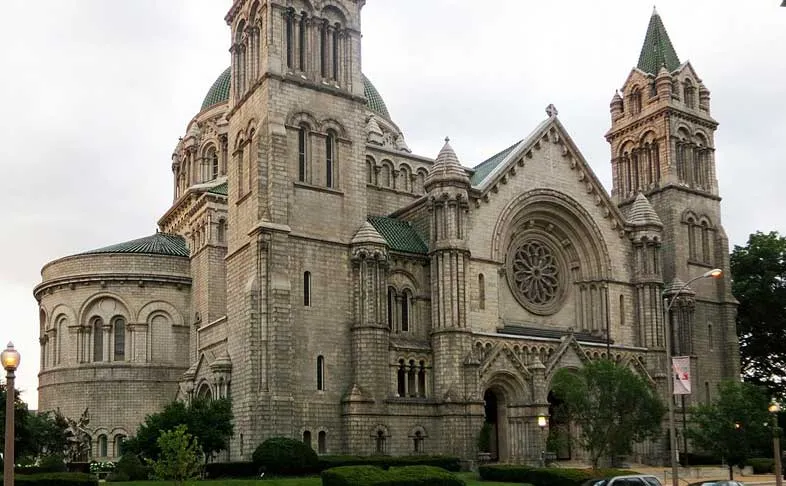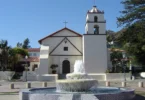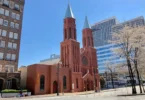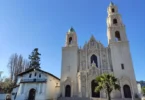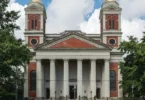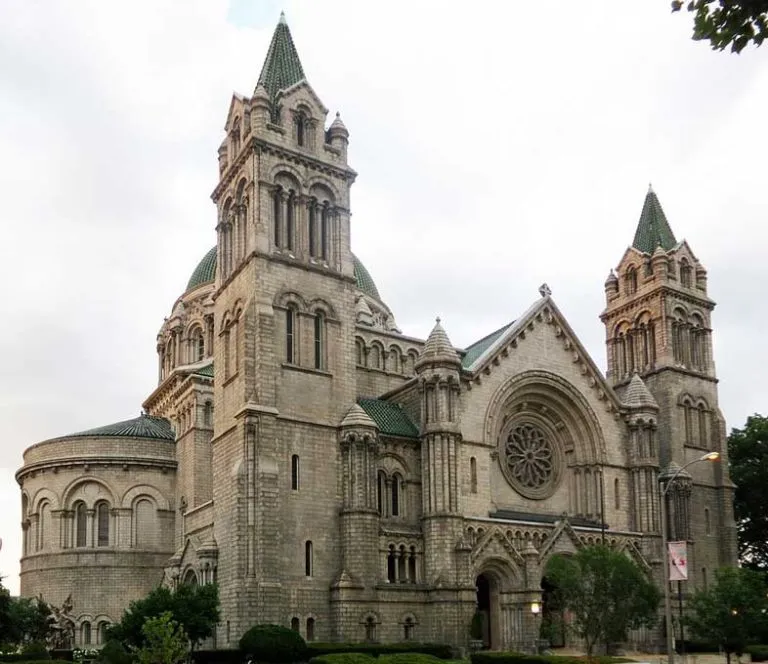
Introduction
The Cathedral Basilica of Saint Louis, also known as the Saint Louis Cathedral, is a cathedral of the Roman Catholic Church located in the Central West End neighbourhood of St. Louis, Missouri. Completed in 1914, it is the mother church of the Archdiocese of St. Louis and the seat of its archbishop, currently Mitchell T. Rozanski. The cathedral is named for Saint Louis and was designated a basilica by Pope John Paul II in 1997.
The Cathedral Basilica of Saint Louis, Missouri was built as a replacement for the previous Saint Louis Cathedral, now the Basilica of Saint Louis, King of France, located along the Mississippi River. Although workers began clearing ground for the building on May 1, 1907, dedication of the Cathedral and its first Mass did not take place until October 18, 1914, when the superstructure was complete. Consecration of the church took place more than a decade later on June 29, 1926.The church is known for its large mosaic installation (which is one of the largest in the Western Hemisphere), burial crypts, and the addition of an outdoor sculpture to promote racial harmony.
Planning for the Cathedral Basilica of Saint Louis, Missouri began under the authority of Archbishop Peter Richard Kenrick in the 1870s and 1880s, and a fund was created for the construction of the building by Archbishop John Joseph Kain. A formal organization promoting the new cathedral was created on April 28, 1871, and among the members of the St. Louis Cathedral Building Association were Archbishop Kenrick, Bishop Patrick John Ryan, and a variety of local businessmen. Initial site selection indicated that the new cathedral would be built on a city block bounded by 22nd and 23rd streets, and by Pine and Chestnut streets, at a location east of the actual construction site.
However, the initiative for construction was only begun after the elevation of Archbishop John J. Glennon. The architecture firm of Barnett, Haynes & Barnett was selected, and Thomas P. Barnett led the design team for the project. A ceremony was conducted on May 1, 1907, for the groundbreaking of the site, and a formal laying of the building’s cornerstone took place on October 18, 1908. By 1914, enough of the building was complete for a dedication ceremony, yet full consecration did not take place until June 29, 1926. Even after consecration, completion of the cathedral’s mosaics was not accomplished until 1988.
On December 20, 1943, a Solemn Pontifical Mass of Requiem was offered for Butch O’Hare, US Navy fighter pilot and Medal of Honor winner. The grounds of the Cathedral also contain the distinctive circular Chancery Building, circa 1965, designed by the Peruvian-American modernist architect Wenceslaus Sarmiento.

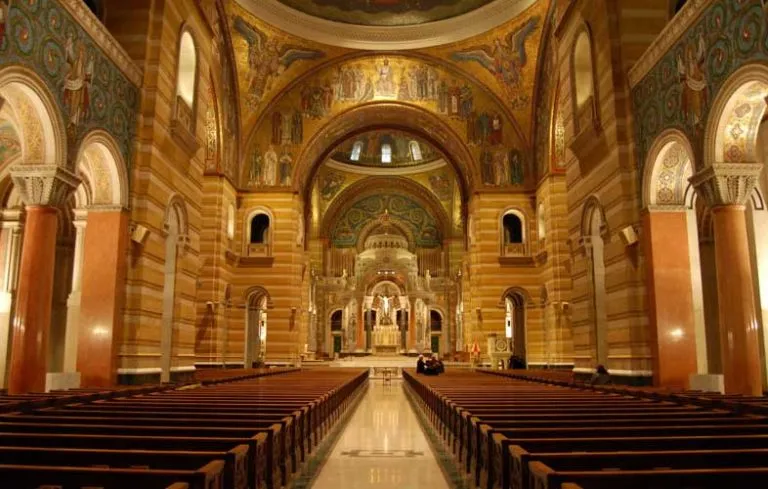
History of the Cathedral Basilica of Saint Louis
Even before Archbishop John J. Glennon announced “I propose to build a temple in the name of the Lord my God,” in February of 1905, plans for a new Cathedral for the Archdiocese of Saint Louis were already underway. Archbishop Glennon’s predecessor, Archbishop John J. Kain had already purchased the property at Lindell and Newstead. However, his plans were set back by a devastating tornado that drained the Archdiocesan treasury and his own ill health. He remained steadfast in his desire to see the Cathedral built, and when he died, he designated his entire personal estate to the Cathedral building fund.
The undertaking would require a $1,000,000 – a monumental sum in the currency of the time (and by no means reflective of the actual cost of the completed building). The design of George Barnett of the firm of Barnett, Haynes and Barnett of St. Louis, a synthesis of Byzantine and Romanesque design, was chosen by a selection committee. On May 1, 1907, ground was broken, and construction began. Work on the Cathedral would continue for another 80 years.
Apostolic Delegate Archbishop Diomede Falconio laid the cornerstone on October 18, 1908, dedicated to the Victorious Christ and Saint Louis IX, King of France, patron saint of the city. The ceremony was observed by members of all 77 Saint Louis parishes, who joined in procession to the site.
The Cathedral Basilica of Saint Louis, Missouri as the structure rose out of the ground, Tiffany and Company of New York began work on the two chapels on the west side of the building. The construction of the High Altar began. The altar was the gift of Mr. and Mrs. William Cullen McBride, whose daughter Kathleen would become the new Cathedral’s first bride. That first wedding happened in 1914, just two days after the first Holy Mass was celebrated in the new and far-from-completed building. The first Mass was celebrated six years to the day after the laying of the cornerstone.
One milestone followed another: In 1915, the new Kilgen organ, now displayed in the Cathedral Basilica’s Mosaic Museum), was dedicated. The Archbishop presided over the first Solemn Mass celebrated at the new High Altar on All Souls Day of 1916, and in 1917, the Blessed Sacrament Chapel was used for the first time. Its bronze gates had graced the Austrian exhibit at the Saint Louis 1904 World’s Fair.
The German firm of August Wagner was contracted to install the mosaics. The company set up shop in St. Louis, becoming the Ravenna Mosaic Company. Following the design of the artisans, Paul Heuduck undertook the red and gold designs of the transept galleries, then completed the Arch of Triumph and the Arch of Creation, followed by the pendentives underscoring the main dome and the Doctors of the Church pendentives surrounding the Sanctuary Dome.
The Cathedral Basilica of Saint Louis, Missouri was ready for consecration. It was an unforgettable occasion for all of Saint Louis. June 29, 1926, the Centennial of the creation of the Diocese of Saint Louis, saw 59 archbishops and priests gather for the ceremonies, including John Cardinal Bonzano, Apostolic Delegate to the United States. More than 100,000 people gathered along Lindell Boulevard to witness the procession of the Blessed Sacrament that evening.
Still there was much to be done. In 1930, the mosaics depicting the life of Saint Louis were completed in the Cathedral’s narthex, visually preparing the visitor for the growing grandeur inside. Shortly after World War II, a sacristy was added to the north end of the structure. The Kilgen organ was replaced, and work on the mosaics continued. It was not to be completed until 1988, when the final two areas – the east and west transepts – were completed.
In 1997, the Cathedral Basilica of Saint Louis, Missouri was designated as a Cathedral Basilica by Pope John Paul II, who honored the Cathedral Basilica with a visit on his history-making visit to the United States in January of 1999. The symbols of its status – the tintinnabulum (bell) and the ombrellino (umbrella) – flank the High Altar reminding one and all of the special status as a Cathedral Basilica.
Even though the Cathedral Basilica of Saint Louis, Missouri is technically completed, there will be changes and additions as each generation adds its imprint to this very special sacred space. The Sacred Heart of Jesus Shrine, located in the west transept, is the most recent addition to the Cathedral Basilica of Saint Louis. It was consecrated by Archbishop Raymond Burke on June 17, 2007.

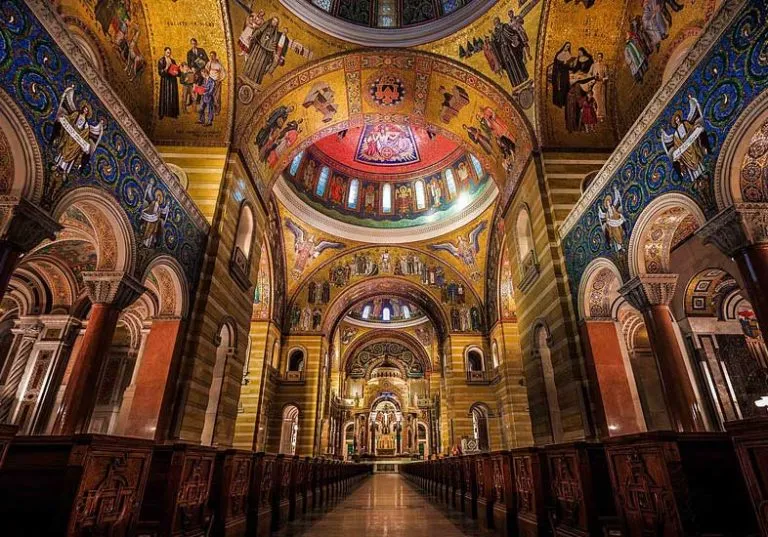
Architecture
Architectural styles: Byzantine Revival architecture, Romanesque Revival architecture
George D Barnett of Barnett, Haynes, and Barnett of Saint Louis designed the entire structure of the Cathedral including a circular Sacristy on the north end which was not built when the main structure was completed in 1914. The semi-circular Sacristy which was eventually built was designed by George John Magualo of Magualo and Quick.
Barnett also designed the main Altar, the baldachino, and the Lower Sanctuary mosaics. The mosaics were installed by the Gorham Company of New York in 1916. Barnett also designed the Blessed Sacrament Chapel and its mosaics which were installed by Gorham in 1916 and 1917.
George John Magualo of Magualo and Quick of Saint Louis was the architect in charge of the Cathedral Basilica when the sacristy was built and when the major work on the mosaics was resumed under Cardinal Ritter, which had been interrupted by the depression and World War II.
Joseph Murphy of Murphy and Mackey of Saint Louis served as the official architect of the Cathedral Basilica who oversaw the major seven-year exterior renovation program that corrected a moisture problem that was disintegrating the granite walls and roof. He also designed the mosaic shrine of Our Lady of Perpetual Help.
Verner Burks, Jr. of Saint Louis subsequently served as the designated architect of the Cathedral and was on the committee that planned and oversaw the installation of the final mosaics. He also designed the reinstallation of the organ that now reveals the stained glass window and mosaics previously obscured by the old organ. He also designed the structure of the Mosaic Museum.
Chevalier Aristide Leonori designed the Blessed Virgin and All Saints Chapel, and the mosaics in them. The fabrication and installation of the Chapels and mosaics were handled by the Tiffany Company in 1912. Robert Frei of Saint Louis designed & fabricated all the stained glass windows on the balcony level.

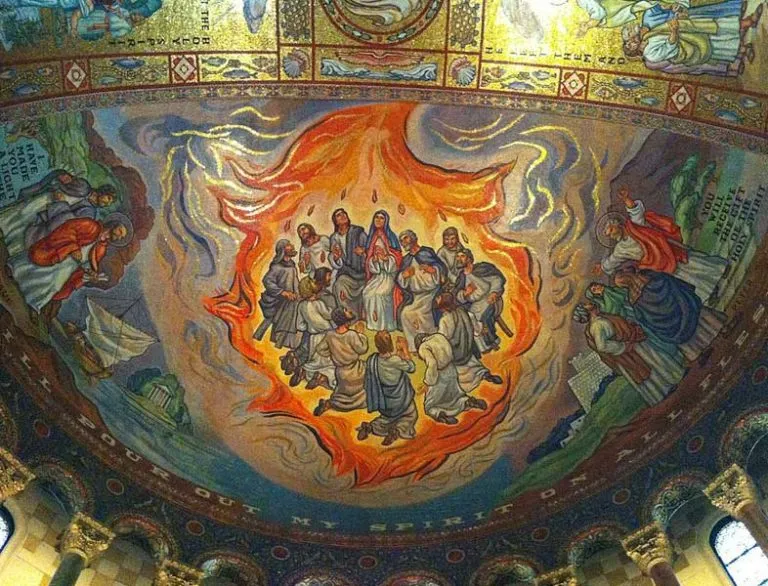
Mosaics
In 1912, installation of mosaics in the interior began. Completed in 1988, the mosaics collectively contain 41.5 million glass tesserae pieces in more than 7,000 colours. Covering 83,000 square feet (7,700 m2), it is the largest mosaic collection in the world outside Russia. While the mosaics in the side chapels and sanctuary walls were designed and installed by Tiffany Studios, the mosaics in the main cathedral areas were designed by August Oetken.
Installation of the mosaics was completed by dozens of artisans, including Hildreth Meiere, Ravenna Mosaic, Inc., and especially the father and son team, Paul and Arno Heuduck, who worked on the mosaic for nearly their entire working lives, and Emil Frei, Inc., of St. Louis. The narthex of the church depicts the life of King Louis IX of France, namesake of the city and church, the rear dome includes mosaics of significant archdiocesan events, while the main dome by Jan Henryk de Rosen depicts Biblical scenes from both the Old Testament and New Testament.
Crypts and Museum
The church basement contains a museum dedicated to the mosaics in the church as well as to some of the other artefacts found within the Cathedral. Also in the church under croft is a chapel dedicated to the souls of former leaders of the Archdiocese. Currently, Cardinals John J. Glennon, Joseph Ritter, and John Carberry, as well as Archbishop John L. May, are buried in the Cathedral’s crypt.

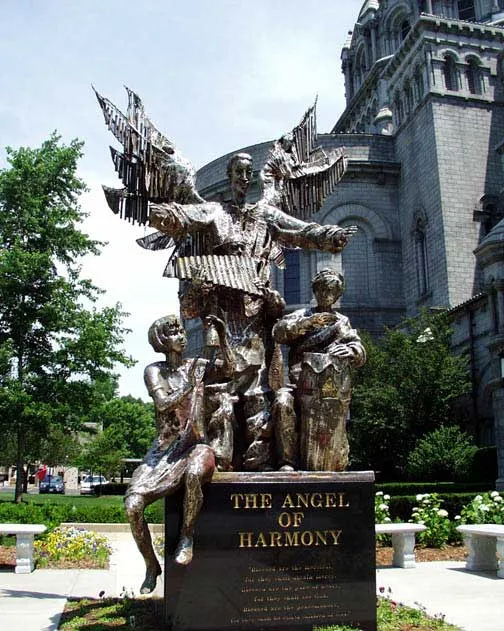
The Angel of Harmony
In 1999, a 14-foot high, welded stainless steel sculpture by Wiktor Szostalo was installed on the side lawn of the church. The sculpture was a gift from Adelaide Schlafly in memory of her late husband, Daniel Schlafly, a Catholic layman who was dedicated to the cause of racial justice and peace. It features a winged angel with African-American features, standing behind three children with Hispanic, Asian and European features, playing a song of peace on their instruments.
The statue’s base is of granite and is inscribed with quotations from the New Testament, Pope John Paul II, and Martin Luther King Jr. The sculpture emphasizes a theme of harmony, peace, and racial justice, according to Auxiliary Bishop Edward Braxton, who suggested the project to Archbishop Justin Rigali.

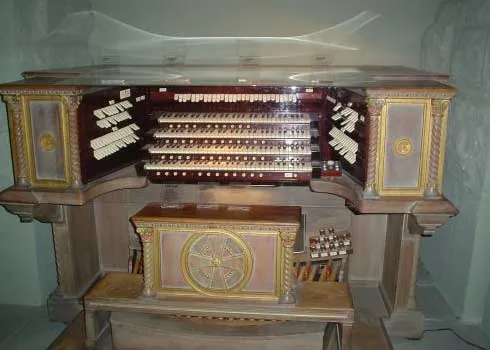
The Organ
The Cathedral has a large organ that was originally built by Geo. Kilgen and Son, Inc., in 1915. Originally, the organ had two four-manual (keyboard) organ consoles, one in the gallery with the organ, and another console behind the sanctuary. In 1946, Kilgen put a new organ into the Cathedral. The 1946 organ had 77 ranks of pipes, 14 of which came from the older organ. In 1948, an Echo Organ from Carnegie Hall, New York City was installed in the Cathedral. In 1984, the M. P. Moller organ company refurbished the organ.
In 1997 the Wicks Organ Company of nearby Highland, Illinois, began a restoration project. They added more ranks of pipes, which brought the organ to 96 ranks of pipes. The company also added some digital stops to the organ. A new four-manual organ console replaced the old Kilgen console behind the sanctuary, and the second gallery console was refurbished. Wicks also updated the organ’s electronics.
In the winter of 2002 the gallery organ was expanded, and a new dome division of pipes was added to the organ. The final step in the project, the replacement of the original gallery console (and a smaller, two-manual console that took its place) with a five-manual console was completed in 2010. The Ragen Organ Console, named for its donor, Professor Brian Abel Ragen, was taken from St. Bartholomew’s Church in New York City and completely restored. It is now possible to control every part of the organ from either the gallery console or the moveable sanctuary console. The original Kilgen console was moved into the basement museum, and can be viewed by visitors. The gallery organ is featured on many of Saint Louis’s cultural tours.
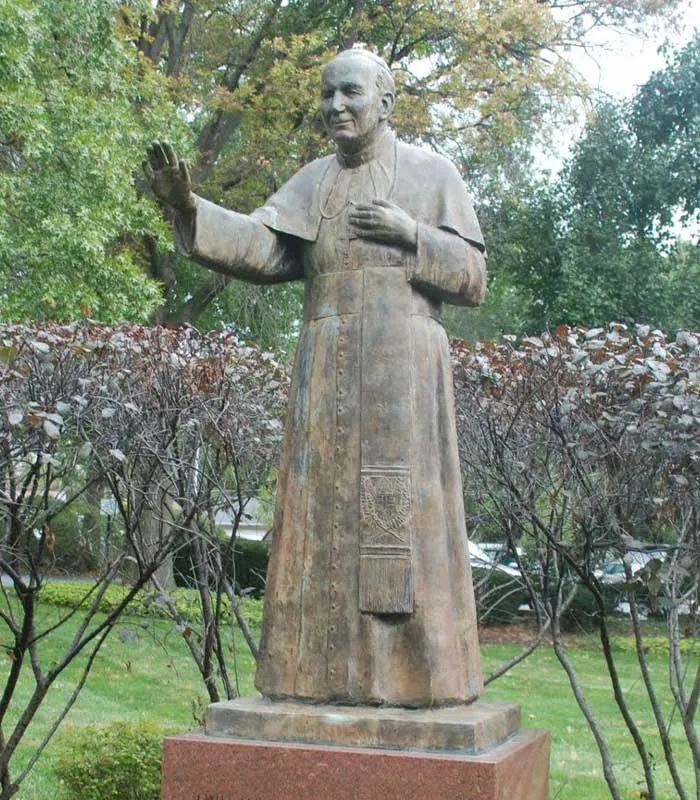
Feast Day – 25th August
Annual Feast of the Cathedral Basilica of Saint Louis, Missouri will be held on 25th August.
Mass Time
Weekdays
Saturdays
Sundays
Church Visiting Time
Museum
The Cathedral Basilica of St. Louis rich history is a one-of-a-kind work of art, inspiring architecture, and transcendent art. With its lofty vaults and radiant mosaics, the sheer scale of beauty is a thing of awe. More than a dozen architects’ and artisans’ concepts and works have coalesced in a magnificently well-integrated and harmonious whole. From top to bottom, front to back, the Cathedral Basilica draws one’s thoughts and emotions upward toward the contemplation of something transcendent.
The museum and tours of the Cathedral Basilica offer any visitor a guided overview of just how much there is to see and learn about the historic site. The museum offers a glimpse at the history of the breathtaking church, its community, and events that led to its completion.
Contact Info
4431, Lindell Blvd, St. Louis,
Missouri, MO 63108, United States
Phone No.
Tel : +1 314-373-8200
Accommodations
How to reach the Cathedral
St. Louis Lambert International Airport, St. Louis Downtown Airport & STL Southwest Terminal are the nearby airports to the Cathedral.
Nearby train stations to the Cathedral are Central West End is a St. Louis Metro Link station, Cortex is a St. Louis Metro Link station & Grand is a St. Louis Metro Link station in St. Louis, Missouri.

